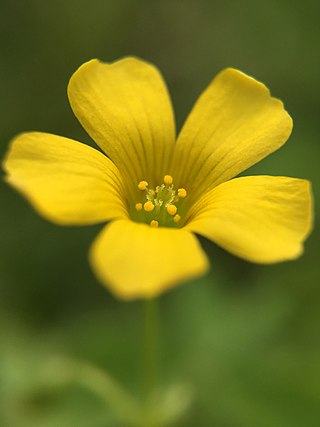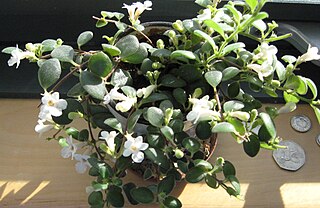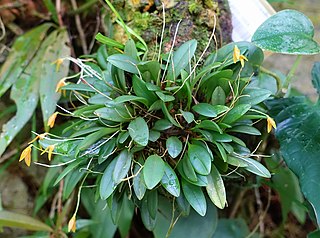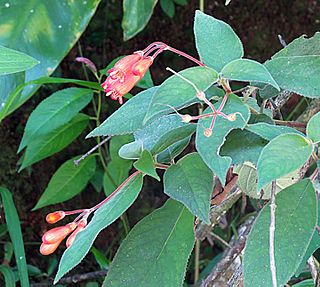
Oxalis corniculata, the creeping woodsorrel, procumbent yellow sorrel or sleeping beauty, is a somewhat delicate-appearing, low-growing herbaceous plant in the family Oxalidaceae.

Gloxinia is a genus containing three species of tropical rhizomatous herbs in the flowering plant family Gesneriaceae. The species are primarily found in the Andes of South America, but Gloxinia perennis is also found in Central America and the West Indies, where it has probably escaped from cultivation.

Columnea is a genus of around 200 species of epiphytic herbs and shrubs in the family Gesneriaceae, native to the tropics of the Americas and the Caribbean. The tubular or oddly shaped flowers are usually large and brightly colored – usually red, yellow, or orange – sometimes resembling a fish in shape. A common name is flying goldfish plants due to the unusual flower shape.

Seemannia is a New World genus in the flowering plant family Gesneriaceae. There are four species in the genus, primarily found in the Andean regions of South America. The name honors the German botanist Berthold Carl Seemann.

Sinningia is a genus of flowering plants in the family Gesneriaceae. It is named after Wilhelm Sinning (1792–1874), a gardener of the Botanische Gärten der Friedrich-Wilhelms-Universität Bonn. There are about 65 species of tuberous herbaceous perennials, all occurring in Central and South America, with the greatest concentration of species occurring in southern Brazil.

Nematanthus is a genus of flowering plants in the family Gesneriaceae. All of its species are endemic to Brazil. Compared to other gesneriads, Nematanthus has leaves that are small, succulent, and hard-surfaced. The plant has a trailing, branching, and spreading habit; it is generally an epiphyte in nature and a hanging-basket plant in cultivation. The flower has fused petals. In some species, the flower has a "pouch" at the bottom. The fancied resemblance of such flowers to a goldfish gives these plants the common name goldfish plant or guppy plant.

Nautilocalyx is a genus of plants in the family Gesneriaceae. Its native range stretches from Costa Rica to southern Tropical America and to Trinidad. It is also found in Bolivia, Brazil, Colombia, Costa Rica, Ecuador, French Guiana, Guyana, Panamá, Peru, Suriname, Trinidad-Tobago and Venezuela.

Paradrymonia is a genus of flowering plants in family Gesneriaceae. It includes 11 species native to the tropical Americas, ranging from Honduras to Bolivia and northern Brazil.

Codonanthe is a genus of mainly epiphytic plants in the family Gesneriaceae, endemic to the Atlantic Forest of Brazil. The botanical name comes from the Ancient Greek for 'bellflower'. They have white or pale pink flowers and somewhat fleshy leaves. In 2013, the genus was reduced in size when more than half of the species were transferred to Codonanthopsis. They can be grown as houseplants, particularly in hanging baskets. Artificial crosses with Nematanthus hybrids have produced the hybrid genus × Codonatanthus.
Codonanthopsis elegans is a plant species in the family Gesneriaceae. It is endemic to Belize.

The Gesnerioideae are a subfamily of plants in the family Gesneriaceae: based on the type genus Gesneria. Although genera typically originate in the New World, some species have become widely distributed as ornamental plants.

Specklinia corniculata is a species of plant native to Belize, Colombia, Costa Rica, Cuba, French Guiana, Guatemala, Guyana, Haiti, Honduras, Nicaragua, Panama, Suriname, and Venezuela.

Codonanthopsis is a genus of flowering plants in the family Gesneriaceae. Its native range is from southern Mexico through tropical America to Bolivia and most of Brazil. Codonanthopsis species are generally trailing epiphytes with pale flowers. Most have a mutualistic relationship with tree-living ants: the plants provide the ants with food, including nectar, and give their nests structure and support, while the ants disperse the plants' seeds. The genus was considerably expanded in 2013 when species were transferred from Codonanthe. Some Codonanthopsis species are cultivated as houseplants, when they may be grown in hanging baskets.
Rufodorsia is a genus of epiphytic flowering plants in the family Gesneriaceae. The genus name refers to the reddish back of the upper lobes of the flower. The relationship of Rufodorsia with the genus Oerstedina is uncertain, as of April 2021. It is native to montane cloud forest in Central America.
Oerstedina is a genus of epiphytic flowering plants in the family Gesneriaceae, native to Mexico, Costa Rica and Panama. The relationship of Oerstedina to the genus Rufodorsia is uncertain, as of April 2021.

Moussonia is a genus of plants in the family Gesneriaceae. Its native range stretches from Mexico to Central America. It is found in Costa Rica, El Salvador, Guatemala, Honduras, Mexico and Panamá.
Codonanthopsis chiricana is a species of flowering plant in the family Gesneriaceae. This species is native to Panama and mainly grows in wet tropical biomes. Codonanthopsis chiricana was first published in 2013.
Codonanthopsis dissimulata is a species of flowering plant in the family Gesneriaceae. This species is native to northern Brazil, Colombia, Ecuador, French Guiana, Guyana, Peru, and Venezuela. Is an epiphyte and mainly grows in wet tropical biomes. The description was first published in 1978.
Codonanthopsis erubescens is a species of flowering plant in the family Gesneriaceae. This species is native to Ecuador and mainly grows in wet tropical biomes. Codonanthopsis erubescens was first published in 2013.
Codonanthopsis luteola is a species of flowering plant in the family Gesneriaceae. This species is native to Panamá and mainly grows in wet subtropical biomes. Codonanthopsis luteola was first published in 2013.












